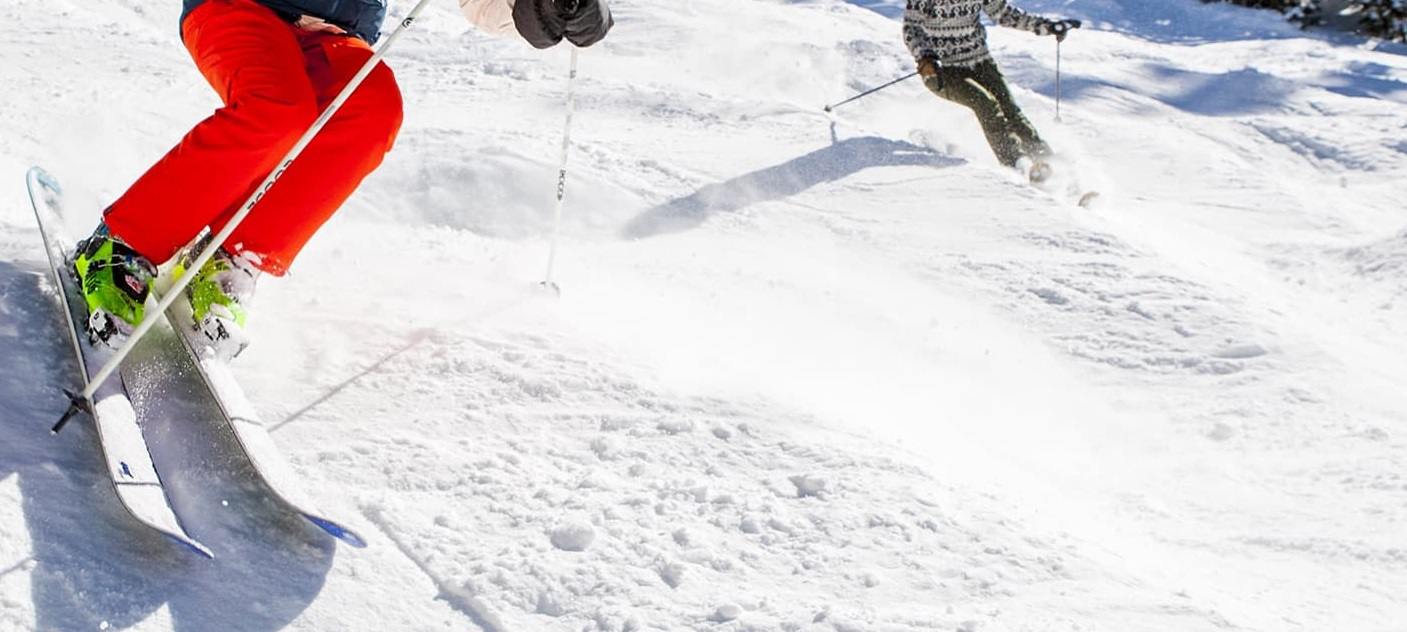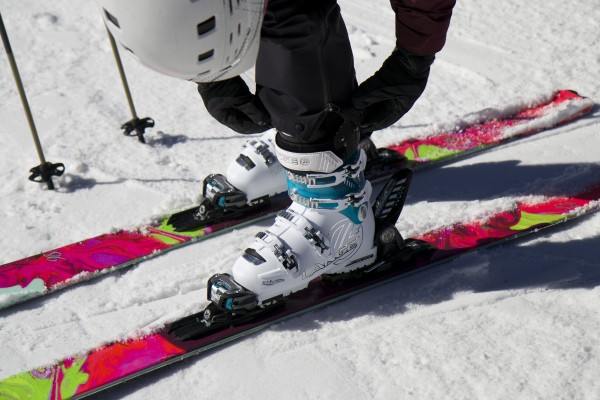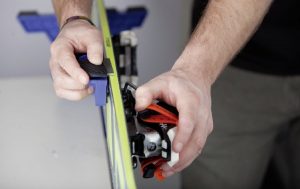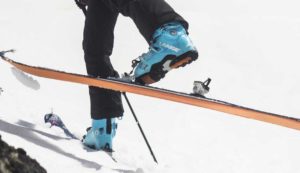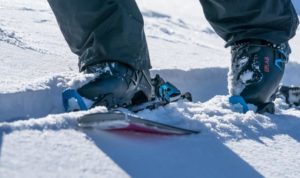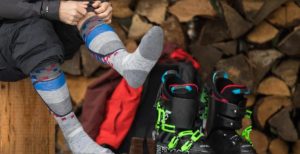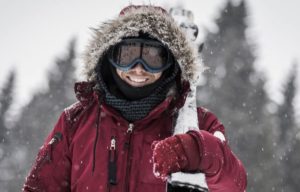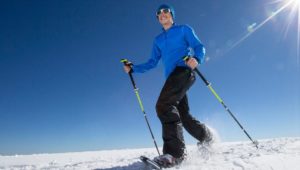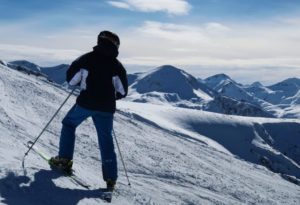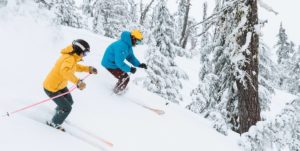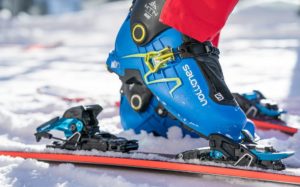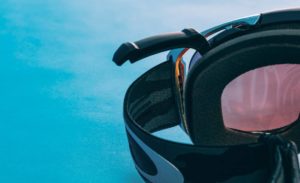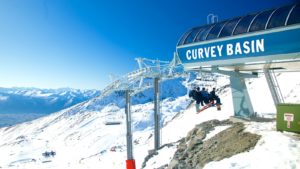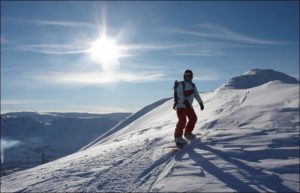What is the best women’s all-mountain ski boot? We put eight top-of-the-line competitors through extensive testing to determine which pairs are the best. We skied hundreds of runs in various conditions, looking for the boot that does it all better than any other. We enlisted a group of dedicated skier ladies for two days of back-to-back round-robin testing and polled them afterward. We evaluated all contenders on comfort and fit, downhill ski performance, features, durability, and warmth. So whether you’re looking for a low-volume aggressive boot or an all-day cruiser, there is a boot out there for everyone. Keep reading to discover which contender is for you.
Related: Best Ski Boots for Men Review
Best Overall Women’s Ski Boots: Tecnica Mach1 105 LV – Women’s
- Extremely responsive
- High-performance boot
- Tight on calves
The Tecnica Mach 1 105 left the competition in the dust in the performance department, outshining all the models in this review. Our advanced to expert skiers think this is the most responsive, fun-to-ski boot, blowing away the long-entrenched former Editors’ Choice Award winner, the Lange RX 110 LV, bumping it from the top spot. The Mach 1’s liner is perfectly matched to its shell and there is almost instant energy transfer from the skier’s foot to the boot to the ski. We had the confidence to take this boot all over the mountain, from the steeps to the crud, right out of the box. If you have lower, muscular calves, you could find the Mach 1 tight up top and you might need to keep the top buckles loose, but with a good boot fitter this problem can be resolved, and you’ll hardly notice it once you get going. The Mach 1 is roomy and comfortable, and you could wear it all day. It has a cushy, warm liner, keeping toes toasty.
Best Bang for the Buck: Dalbello Kyra 95 ID – Women’s
- Comfortable
- Customizable features
- Intuition liner
- Heel lift
A have a friend that refers to the Dalbello Kyra 95 IDs as her “old friends” because they’re so comfortable and easy to ski. They win our pick for best value. This is the perfect boot for an intermediate skier who wants to transition from a relaxed, soft boot to a more advanced, stiffer boot. The Kyra has an adjustable flex, so when you think you’re ready for a more responsive boot, crank it up to hard and you’re ready to go. The Kyra’s shells have been pre-punched out in all the important spaces to add room for common pressure points. Dalbello gives the ID model added value with a warm, custom moldable Intuition liner. The Kyras control fat skis well and there is little heel lift in this boot. These versatile, warm, and relatively high-performing boots retail at only $499.99.
Best Lightweight, High-Performance Boot: Atomic Hawx Ultra 110
We could not believe how light the Atomic Hawx Ultra 110 is when we picked it up for the first time! The Hawx is a great choice for a ripper female skier on the lighter side who wants to be able to drive her skis with authority. Weighing 6lbs 8.9oz, the Hawxs are 1.5 pounds lighter than any other boot tested. Atomic has made this pair performance-oriented as well, and the Hawxs are responsive and so light you can hop turn your way down the mountain. These are a fun, easy boot to ski, and the Hawx’s shell has an acute angle at the ankle that locks your heel down. If you are on the heavier side and like to throw your weight around more and pressure the front of your boots, you will feel that driving the Hawx a is little more disconcerting and the flex will be maybe too soft. However, they are a fun boot, and we recommend them to our friends in the featherweight category.

Choosing the Best Ski Boots for You
Ski boots are the most important piece of gear in your downhill setup, and they require the most patience and knowledge to select. Selecting a pair that is right for you could mean a world of difference to your skiing. If you get a boot that doesn’t fit properly or is too stiff, it could actually hurt your skiing. A boot that is too stiff can create fatigue, making you less confident and in control. Find one that fits like a glove, allowing you to control your skis, and you will be amazed at how it improves your skiing. The right selection comes from considering a combination of factors, including your skiing ability, the terrain you like to ski, and your foot and calf shape. Once you select your boots, be sure not to miss our Review of Women’s skis so you can choose the right pair to get you ripping up the resort.
Types of Downhill Boots
The women’s boots we tested all fall into the all-mountain category. All-mountain downhill boots are the jack-of-all-trades models. They let you go anywhere and do anything at the resort, from skiing corduroy groomers to big powder days and off-piste runs through your favorite stashes. All-mountain boots are not the best boot if you’re looking to jib and jump in the park or whack gates all day. Race boots and freestyle boots are in a different category.
The boots we tested have two predominant constructions, with each manufacturer creating variations on the two themes, adding features to enhance performance and fit. The first is called overlap construction, consisting of two parts: a lower shell and an upper cuff. Boots with overlap construction are seen mostly at the ski resort. They make for a snug, stiff boot that can be difficult to get on and off. Most of the boots we tested are some type of overlap construction. Our favorite overlap boot was the Tecnica Mach 1 105.
The Dalbello Kyra 95 is one of the only boots with the 3-piece cabrio construction in this review. As opposed to the overlap design where the wrapped plastic of the cuff creates the flex pressure the tongue is responsible for creating the flex level.
The second design is called a three-piece or Cabrio. This consists of a lower shell, upper cuff, and a tongue. As opposed to the overlap design where the wrapped plastic of the cuff creates the flex pressure — the tongue is responsible for creating the flex level. Cabrio construction is more popular in alpine touring, freestyle, and mogul boots because they are a bit more forgiving and absorb shock better when tackling bumps. Cabrio construction models are easier to get on and off. The only boot in this review with Cabrio construction is the Dalbello Kyra 95 ID. Full Tilt exclusively makes three-piece construction boots, but we did not test one of their models this year.
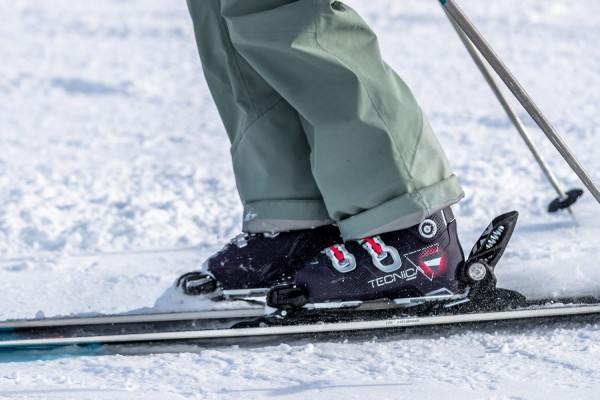
Other Important Components of a Ski Boot Are:
Power Strap: the large Velcro strap on the top of your boot that you can tighten up for extra power and stiffness in your boot. Beware of tightening too much to prevent shin bang.
Liner: The inner boot that is removable. It is the industry standard for high-end boots to come with heat-moldable liners that can be customized to fit your foot so the fit feels snug, secure, and comfortable.
Soles: These are increasingly becoming more grippy and rubberized, especially in boots meant for more side-country travel. All the boots in this review are DIN (alpine binding) compatible. Some of these boots have soles that can be changed out to be compatible with backcountry tech bindings.
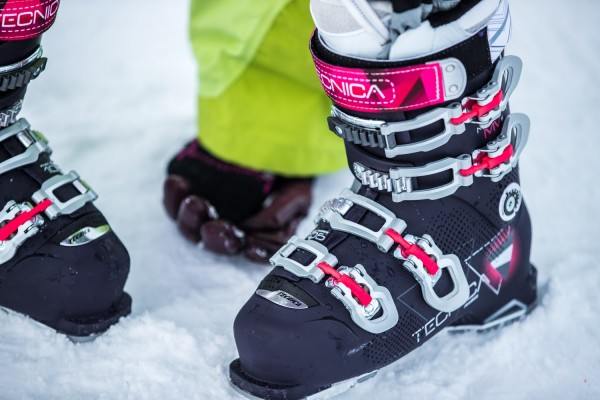
How We Chose
Comfort & Fit
Fit is one of the most important factors in a boot. If you have a boot that fits well, it will also be comfortable. The shape of your foot will determine which boot will fit. If you have a wide foot, you should look for a boot with a medium to wide last (100-106 mm) like the Dalbello Kyra. If you have narrow feet, look for a low volume boot like the Lange RX-110 LV in a low volume version. Because everyone’s feet are different, we looked objectively at the different fit characteristics of each boot. How adjustable are the boots? Features like micro-adjustable buckles and heat-moldable liners help to make a boot more customizable for a better overall fit.
Some boots are inherently more comfortable than others, and some fit better than others. We like the fit of the Dalbello Kyra 95 ID. The Intuition liners hug the ankles and forefeet, and they are cushy. Usually, women with wider feet like the Head Dream 100 because it has room in the forefoot and a soft faux-fur lining. The Salomon X-Pro 90 – Women’ fits like a glove, with a soft micro-fleece lining. If you want to know more about how to properly size and fit a ski boot, reference our Buying Advice article.
For a beginner skier, comfort is one of the most important considerations. You’ll want a boot that you can spend all day standing, walking and cruising the slopes in without discomfort. There are already many elements you’ll battle when learning to ski— an uncomfortable boot shouldn’t be one of them. We would recommend a comfortable, three-buckle boot like the Dalbello Kyra, in the softer 75 flex.
Women’s Specific Fit
We can keep up with the guys, so why not get a men’s boot, right? Wrong. We are entirely different creatures and therefore we should have entirely different boots. Over the years, manufacturers have made leaps and bounds in designing women’s specific boots. The main anatomical difference is in the shape of our lower legs and feet. Men generally have longer, skinnier legs, and their calf muscles sit higher, requiring a narrower fitting cuff. Women have shorter legs and lower calf muscles (and no, we’re not talking about cankles here), so we need a boot that will accommodate this shape with a wider, lower cuff. Men also have wider feet that extend all the way through their heel.
Women need narrower heel and ankle pockets to keep their feet in place, allowing them to confidently drive the ski. The Atomic Hawx Ultra 110 has the most heel hold we’ve ever experienced. The Lange RXs have a great narrow heel, and the Dalbello Kyra seems to have the lowest, women’s specific cuff. If you are looking for a boot more similar to a men’s fit, the Tecnica Mach 1 boots seem to have a slightly narrower, taller cuff and more room in the heel, like a man’s boot. This could be a good option for a taller woman with slim calves.
Women are generally lighter than their male counterparts, and therefore have less weight to throw around. This affects women’s ability to flex into boots, and ladies tend to have a harder time driving stiff boots — so an expert women’s boot will have a lower flex rating than the men’s version (like 110 vs 130). Manufacturers use lighter materials in women’s boots so the haul from the parking lot to lift is a bit easier. The lightest boots in this review are the Atomic Hawx Ultra 110.
Women have a different center of gravity that is lower in the hips, making it more difficult to stay forward and out of the back seat when skiing. Manufacturers acknowledge this and typically increase the ramp angle — the angle under the boot sole — so that it is easier to stay forward. Women generally feel colder than men. Many women’s models have added insulation and features like faux-fur lining to keep toes toasty. Manufacturers also usually make women’s versions with colors and flashy extras that can be appealing, like on the Rossignol Alltrack Pro, although we’ve noticed this year that the boots are more serious looking and in darker colors.
Ladies, if you’re thinking about going with a men’s boot, we entreat you to change your mind, for all the reasons mentioned above. And if that doesn’t convince you — maybe the fact that women’s boots seem to be less expensive will be the kicker.
Downhill Ski Performance
The process of turning your skis starts in your brain, which triggers your legs, which instruct your boots and finally move your skis. Having a high-performance ski boot can speed up this process. Depending on your skiing ability, you may want a boot that is more or less aggressive and performs differently. Advanced to expert skiers look for a boot with a tighter fit so their foot does not move around inside, and they prefer a stiffer flex so that their movements are immediately transferred from boot to ski.
Your weight will also affect your ability to drive a stiffer boot; if you’re on the lighter side, you may want a softer boot, like the Atomic Hawx or the Head Dream 100 – Women’s. The boots we tested are all in the 90 to 110 flex range, which is more suited for advanced to expert level skiers. If you are a beginner or intermediate level skier, you will want a boot that is not as stiff, allowing you to control and stay on top of your skis with ease — although they may not be as responsive. All of the models tested are available in softer flexes for intermediate skiers.
When scoring this category, we looked for boots that we could drive easily, with responsive and predictable flex, without throwing us in the backseat, where we had less control. We tried all the boots on different skis, from skinny carving skis to fat rockered skis, to see if they could control the gambit. We skied them on and off-piste to test their performance on varied terrain and in all snow types. When tested back to back, we found some had stiffer or softer flexes than advertised. The Lange RX-110 LV felt softer than the advertised flex, more in the 100-105 range, while the Tecnica Mach 1 105 felt stiffer than the advertised 105 flex — somewhere in the 110-115 flex.
We unanimously agreed that the Tecnica Mach 1 is the highest performing, most responsive boot tested. We love carving tight turns, bumping moguls, and skiing off-piste in these boots. The Lange RXs are also the lowest-volume, tightest fitting boots, which would often cut off toe circulation, so they are not the boot for people with constantly frozen toes. We were disappointed in the Rossignol Alltrack Pro; they have a relaxed, roomy fit that feels like we can never get them tight enough.

Features
Most of the all-mountain boots tested have features that made them stand out. We looked at the boots’ features, and how well these features work. The first task was to determine what is flashy marketing and what is actually useful. The most notable features were walk/hike modes, customizable liners, micro-adjustable buckles and other features that tweak size and performance such as flex adjustments, cuff size modification capability, heel lift, and canting alterations.
To get the most out of the features your boots have to offer, it is a good idea to see an experienced boot fitter. All of the boots tested are specific for women and were made to work better for women’s feet, calves, and skiing abilities.
More ski boot manufacturers are getting into the all-mountain adventure category, creating boots that have great downhill performance as well as features that make them better for side-country forays. Typically these boots are lighter and have walk modes and interchangeable soles so you can use them with alpine or tech bindings. None of the boots tested this go-around fall in this category, and the Dalbello Kyra 95 are the only boot with a walk mode. However, we would take the Atomic Hawx on short side country walks because they are so light.
The liners a boot comes with are an important piece of the fit puzzle. Our favorite liners were the Dalbello Kyra’s fully moldable Intuition liners. We also really liked the Salomon XPro 90 – Women’s Custom Shell 360 liner because it has adjustment options and already has areas that are articulated, such as around the ankle bone.
Beginner skiers should look for a boot that has a lower, more comfortable cuff, potentially with three buckles and a softer flex. Walk modes are a great feature in a beginner mode for walking from the parking lot and short distances up the bunny slope for practice.
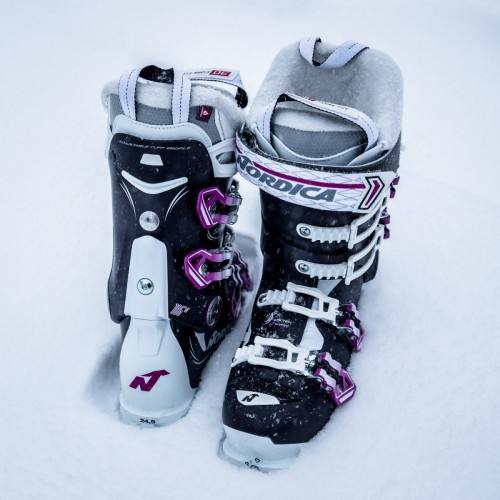
Durability
You spend a lot of money on these boots, so you want them to last. Most of the boots tested were very burly and durable, but we noticed a few things that may be problematic over time. We checked the boots for dents, the soles for wear, and other features that seemed to be lower quality. We think the Nordica Speedmachine 105 and the Lange RX 110 LV are the most durable, whereas the Rossignol AllTrack Pro’s flashy appearance and soft faux-fur appear to be less durable.
We have noticed that boots with white shell materials show scuffs more easily, and the trend this year is for boots to be black or dark colored — no boots this year were white! We worry that boots with cable buckles like Dalbello Kyra are less durable than traditional buckles, but they seem to be relatively easy to replace. The Salomon XPro 90 had a plastic button pop off when we were prying the cuffs open in the cold, and we worry that the Atomic Hawx’s shell liner could sustain damage because it’s so thin!
Warmth
To test for warmth, we evaluated these boots on their fit and liner materials. Typically, boots with a roomier fit feel warmer because they allow for plentiful blood flow, whereas boots with a tight fit feel restricting and therefore colder. If your boots are cutting off your circulation, your feet will feel colder. We found the Dalbello Kyra’s Intuition brand liners to be the warmest; the roomy Nordica Speed Machine 105 were warm too, scoring a near-perfect 8 out of 10.
We found the Lange RX to be the coldest (scoring a 7 out of 10) because they have a tight, lower-volume fit that tends to cut off circulation, especially for people with wider feet. In some situations, we preferred to deal with cold feet in exchange for performance, and would just unbuckle our boots on the lift to get some circulation back. But most of the time we’d rather have a warm, comfortable boot like the Head Dream that they could wear all day without adjusting.
Conclusion
Selecting the right pair of boots can make quite a difference in your skiing, not to mention your performance. Ultimately, the correct pair of boots will leave you comfortable and in control. With this review, we hope to explain the differences in boot models available to guide you in the direction of a pair that will work for you.

